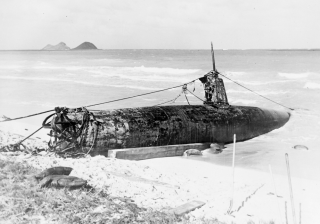Japan Planned To Use Midget Submarines To Attack Pearl Harbor From The Inside
A secret attack from under the waves.
The crew of Ha-18 abandoned ship without firing either of their torpedoes after falling victim to a depth charge attack. Nineteen years later, the U.S. Navy recovered the sub from the floor of Hawaii’s Keehi Lagoon and ultimately shipped it off for display at the Japanese Naval Academy at Etajima.
The fate of the fifth submarine, Ha-16, remains controversial. At 10:40 P.M., the crew of the I-16 intercepted a radio message that appeared to repeat the word “Success!” A few hours later, they received a second transmission: “Unable to navigate.”
The belief was that Ha-16 transmitted these alerts. In 2009, a Novadocumentary crew identified three parts of the midget submarine in a navy salvage pile off of West Loch, Hawaii.
A popular belief is that Ha-16 successfully entered the harbor and fired off its torpedoes. Then the crew slipped out and scuttled the sub off of West Loch island before perishing of unknown causes.
U.S. Navy salvage teams probably later scooped up the sub amidst the wreckage of six landing craft destroyed in the West Loch disaster of 1944. They then proceeded to dump the whole pile of debris further out at sea.
That no one ever found the Ha-16’s torpedoes gave rise to the theory that the midget submarine might have successfully torpedoed the battleship USS Oklahoma. The USS West Virginia was another possible target.
A photo taken from an attacking Japanese torpedo bomber at 8:00 A.M., which appears to show torpedo trails lancing towards Oklahoma without a corresponding splash from an air-dropped weapon added more weight to the idea. In addition, the damage to the Oklahoma, and the fact that it capsized, suggested to some it was struck by a tiny sub’s heavier torpedoes.
However, this theory is dubious. The Oklahoma capsized because all the hatches were open for an inspection at the time of the attack. The heavy damage can be explained by the more than a half-dozen air-dropped torpedoes that hit the ship.
It is more likely Ha-16 launched the torpedoes at another vessel. At 10:04 A.M., the light cruiser USS St. Louis reported it had taken fire from submarine, but both torpedoes missed.
In the end, the air attack accomplished what the midget submarines could not. Japan’s naval aviators sank three U.S. battleships, crippling another five, blasted 188 U.S. warplanes — most sitting on the ground — and killed 2,403 American service members.
Unfortunately for officials in Tokyo, the Japanese Navy had struck a powerful blow, but not a crippling one. The bombardment failed to hit the repair facilities and fuel depots, which allowed the U.S. Pacific fleet to get back on its feet relatively quickly.
Just as importantly, not a single U.S. aircraft carrier was in Pearl Harbor at the time. The flattops would swiftly prove their dominance over battleships in the coming Pacific War.
Despite the debacle, the Japanese Navy continued sending Kō-hyōteki into combat. As at Pearl Harbor, the submariners in their tiny ships had very limited successes in operations from Australia to Alaska to Madagascar.
This first appeared in WarIsBoring here.
This article first appeared earlier this year.
Image: Creative Commons.

